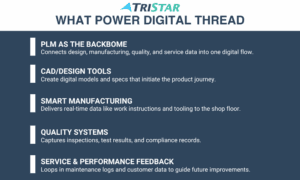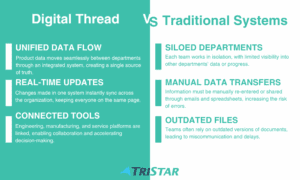July 1, 2025
What is the Digital Thread? A Simple Guide for Engineers and Manufacturers
READ TIME: 5.1 MINS
The Short Answer: A digital thread creates a connected flow of product data across the entire product lifecycle, from initial product design through the manufacturing process and service. This digital backbone links together previously disconnected enterprise systems to give teams a comprehensive view of a product’s journey while enabling faster, more informed decisions.
Current Industry Challenge
Manufacturing companies today face mounting challenges from scattered digital data across various systems and departments. Product designs, engineering changes, production data, and service records often exist in isolation, making it difficult for design engineers to access the information they need. As products become more complex and customizable, this fragmented approach leads to delays, errors, and missed opportunities for improvement.
The digital thread technology solves manufacturing challenges by creating a single source of truth for product data. It connects information across production systems and processes, delivering real business value for engineers and manufacturers through streamlined workflows and enhanced collaboration. Whether you’re new to digital manufacturing or looking to advance your current capabilities, connecting your product data drives better decisions across your organization.
Understanding Digital Thread Basics
Fundamental Concepts
A digital thread is a connected flow of digital data that spans the entire product lifecycle, from initial product design through manufacturing, service, and retirement. Think of it like a product’s digital DNA—just as DNA carries genetic information through an organism’s life, the digital thread concept carries product information through every stage of development and use.
The concept rests on establishing digital continuity, where data moves smoothly between various systems and departments without being lost or corrupted. For example, when a design engineer makes changes in CAD software, that update automatically flows to manufacturing systems, quality control, and service documentation. This eliminates the traditional problem of information being trapped in separate systems or outdated files.
Key Components
The digital thread technology weaves together several essential elements that make up a product’s life cycle. At its core is Product Lifecycle Management (PLM), which serves as the backbone connecting different types of production system data. This includes engineering designs from CAD systems, manufacturing process plans, quality control data, and performance data.
The thread enables real-time collaboration by integrating:
- Design and digital engineering data like 3D models and specifications
- Smart manufacturing information including work instructions and tooling details
- Quality and compliance requirements documentation
- Service and maintenance records
- Customer feedback and product performance data
Digital Thread vs. Traditional Systems
Traditional product development relied on disconnected systems where information had to be manually transferred between departments, often leading to errors and delays. The full digital thread represents a fundamental shift from this fragmented approach.
In traditional systems, data typically existed in isolated silos with limited sharing between groups. Updates happened in batches, meaning teams often worked with outdated information. Digital thread technology, in contrast, provides real-time data access across the organization. When changes occur, everyone sees them immediately.
Benefits and Business Impact
Operational Improvements
Manufacturing organizations that implement digital thread technology see clear advantages in their day-to-day operations. Teams across departments work together more effectively as data flows smoothly between design, engineering, manufacturing, and service groups. This helps staff make faster, better-informed decisions since they have access to current product information exactly when needed.
Industry data shows that companies using digital thread solutions report up to 75% fewer errors and design iterations. When issues arise, teams can trace them back to the source and implement fixes more quickly. The connected nature of digital thread also means changes propagate automatically across systems, removing manual data entry and the mistakes that come with it.
Financial Benefits
The financial impact of digital thread adoption is significant and measurable. Organizations typically see time savings of 30-50% in product development cycles by eliminating duplicate work and speeding up reviews and approvals. Design changes that previously took weeks now happen in days.
On the cost reduction side, companies report 20-40% lower product development expenses through better resource use and fewer mistakes requiring rework. The ability to catch and fix issues early in the design process, rather than during manufacturing, delivers major cost avoidance. Digital thread also reduces inventory costs by providing better visibility into actual material needs.
Quality Enhancements
Product quality improves substantially with digital thread implementation. Having a single source of truth for product data means fewer inconsistencies between design intent and manufactured items. Detailed traceability allows teams to quickly identify and resolve quality issues before they impact customers.
The technology also helps companies maintain compliance with industry standards and regulations more easily. Since all product data is connected and trackable, generating documentation for audits becomes straightforward. Organizations can prove their products meet requirements through the entire lifecycle, from initial design through manufacturing and service.
Based on the research, I’ll craft the Implementation Components section focusing on the key technical and process elements while maintaining the specified tone and structure:
Technical Infrastructure
Product Lifecycle Management (PLM) forms the backbone of any digital thread implementation. The technical foundation requires:
- A PLM system that can connect and manage product data across engineering, manufacturing, and service
- Data management platforms that support multi-CAD environments and various file formats
- Integration capabilities through standardized APIs to link existing enterprise systems
Process Framework
Creating a working digital thread demands clear protocols for data flow and management:
- Standard data formats and naming conventions across departments
- Documented workflows showing how information moves between teams
- Version control and change tracking procedures to maintain data accuracy
- Quality control checkpoints to validate data integrity
Implementation Strategy
Organizations can build their digital thread capabilities through a carefully planned phased approach. The journey typically begins with implementing a pilot program in a single department or product line to test and refine the process. Teams then need to thoroughly map their current systems and identify key integration points where data flows can be connected. With this groundwork in place, realistic timelines must be outlined for each implementation phase, ensuring smooth transitions and minimal disruption. Finally, careful calculation of required budgets and resource allocation helps ensure the initiative has the necessary support and funding to succeed throughout its lifecycle.
Success Factors
Several elements determine whether a digital thread implementation will deliver value:
- Leadership support and clear communication of goals
- IT systems ready to handle increased data flow
- Well-defined processes before adding technology
- Training programs to help teams adapt to new workflows
- Regular assessment of progress and adjustments as needed
Embracing the Digital Thread Revolution
The digital thread represents a powerful shift in how manufacturers connect and utilize product lifecycle data across their organizations. By linking product design, engineering, manufacturing process, and service information in a single, accessible flow, companies gain faster product development cycles, better quality control, and improved customer satisfaction. Getting started means focusing on the basics: organizing your digital data, connecting various systems, and building cross-functional collaboration.
Get Started with TriStar
TriStar specializes in helping manufacturers build and optimize their digital thread implementations through digital transformation. Our expert team works closely with clients to evaluate their current manufacturing systems, define clear requirements, and develop practical roadmaps for success. We understand the challenges of connecting disparate digital tools and processes, and we bring decades of experience in PLM, CAD, and smart manufacturing to every project.
Ready to start building your full digital thread? Connect with TriStar’s PLM specialists for a no-obligation consultation. We’ll help you assess your readiness and outline practical next steps for your organization. Contact us today or call us to schedule your consultation today.
TriStar Digital Thread Solutions welcomes questions. Feel free to CONTACT US if you can’t find what you’re looking for, or call us at 800-800-1714









